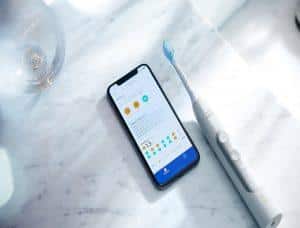Is a Waterpik or Water Flosser a Good Alternative to Traditional Flossing?
The top two methods to clean between your teeth are traditional string floss and water flosser or
the Waterpik. Traditional string floss involves running a string of floss between teeth by hand.
Water flosser or the Waterpik is a great tool which uses a jet of water to remove plaque and
debris from around and in between teeth. Both are great for removing plaque and debris from
the teeth and keeping gums healthy.
While the water flosser is extremely effective, it is not a
replacement for regular string flossing. Think of plaque between the teeth like grease and food
on a pan. Floss is like a scrub to loosen some grease and food.
Waterpik is like a spray that removes the grease and food off. However, many people find string floss difficult to use,
especially for the back teeth. It is better to choose to do some sort of flossing method daily than
choosing to do nothing at all. Ideally the patient should use both.
Who would benefit most from using a Waterpik or water flosser?
1) People with gum disease:
According to the Canadian Dental Association, 7 out of 10
Canadians will develop gum disease (gingivitis or periodontitis) at some point in their
lives. So most dentate adults would benefit from using a Waterpik.
2) People undergoing orthodontic treatment:
Patients who are undergoing traditional orthodontic treatment with either metal braces or aligner therapy (Invisalign) would have more difficulty with keeping their gums and teeth clean due to the brackets and wires and or aligner attachments on their teeth. Water flossing can be very helpful in removing trapped plaque and debris. Make sure to use the orthodontic tip for a more effective clean.

3) People who have veneers, crowns and/or bridges:
Dental work like veneers, crowns and bridges can be difficult to keep clean. Along the margins or
beneath the bridges are areas where patients are likely to find the most plaque accumulation. That is why it is important to remove plaque everyday and reduce cavity risk around your dental work
and prolong the longevity of any dental work. Using the water flosser right after eating
also helps neutralize the acid from eating carbohydrates as it flushes the acid away
(which a traditional string floss cannot complete with). Make sure to use the plaque
seeker tip which has three thin tufts of bristles to access stubborn plaque around
crowns, bridges and veneers.
4) Implant patients: Implant is critical for long-term implant success. Plaque and bacteria
that form around an implant can cause gum inflammation and lead to peri-implant
disease such as peri-implant mucositis (similar to gingivitis) and peri-implantitis (similar
to periodontitis). The plaque seeker tip is the recommended tip for people with implants.
Which model of Waterpik should I pick?
Waterpik is the most popular brand of water flosser. Even within the Waterpik brand, there are
many different models to choose from. While they are all effective in terms of plaque removal,
the top considerations to consider are:
1) Water pressure:
The countertop versions offer a greater range of water pressure extra
gentle pressure to maximum cleaning. Patients who have gum disease may have more
sensitive gums and may benefit from starting out with an extra gentle setting, and slowly
work their way up to a higher power.
2) Reservoir Capacity:
Depending on the pressure setting used, water flossing can be
completed for 60-90 seconds with a countertop model compared to 30-45 seconds for a
cordless model. In general, a cordless model may mean that you need to refill 2-3 times
for a full clean.
3) Size and portability:
While the cordless water flossers have lower pressure ranges and
smaller reservoirs, cordless Waterpik in helpful for:
○ Bathroom with smaller countertop or limited storage space
○ Travel
○ Use in shower (waterproof cordless model)
○ As an alternative to your countertop when you are away from home
How often should I use a Waterpik or water flosser?
In general, most adults can benefit from using the Waterpik just once a day. People who have
gum disease (gingivitis or periodontitis) or significant dental work can benefit from using
Waterpik 2-3 times a day each time after eating.
If you have any questions regarding the Waterpik, feel free to ask your friendly dentists Dr.
Huang or Dr. Chiu at your next appointment at Casa Dental.









 REQUEST AN APPOINTMENT
REQUEST AN APPOINTMENT